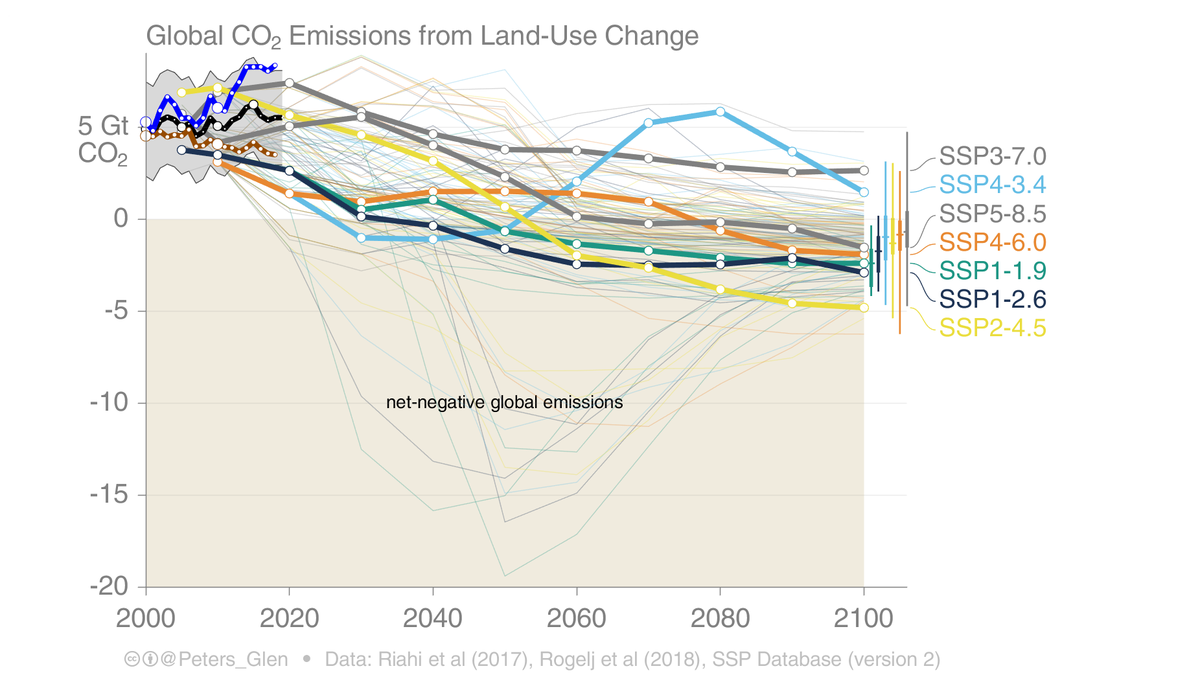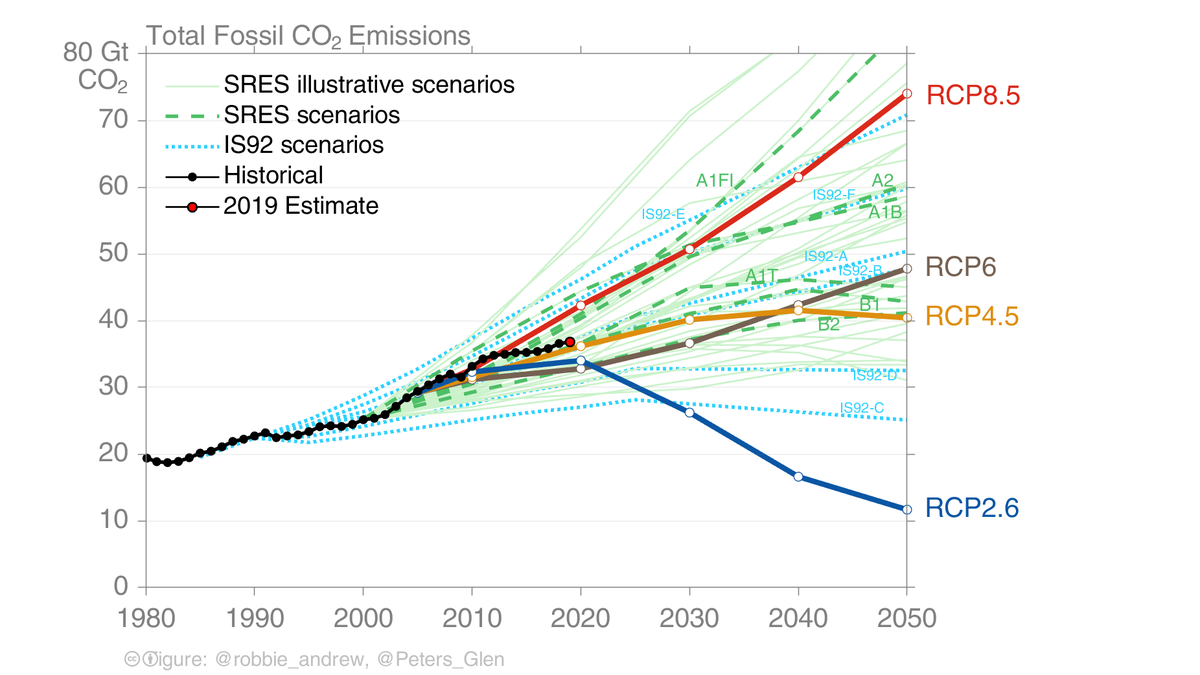Do scenarios adequately explore uncertainty in land-use change emissions?
CO₂ emissions from LUC vary little across scenarios, with baselines (grey) & mitigation scenarios having large overlaps.
Historical datasets highly uncertainty (left side).
Why does this matter?
1/
CO₂ emissions from LUC vary little across scenarios, with baselines (grey) & mitigation scenarios having large overlaps.
Historical datasets highly uncertainty (left side).
Why does this matter?
1/
For historical data, the @gcarbonproject takes the average of two bookkeeping models as its & #39;best estimate& #39;.
The two bookkeeping models show completely different trends in the last decade. Which is correct?
https://essd.copernicus.org/articles/11/1783/2019/
2/">https://essd.copernicus.org/articles/...
The two bookkeeping models show completely different trends in the last decade. Which is correct?
https://essd.copernicus.org/articles/11/1783/2019/
2/">https://essd.copernicus.org/articles/...
The DGVM results from @gcarbonproject are more closely aligned, on average, to BLUE. Though, the uncertainty here is large...
(NB: older version of figure, so ignore last 2 points from BLUE)
3/
(NB: older version of figure, so ignore last 2 points from BLUE)
3/
Why does this matter?
When assessing whether scenarios are "on track", one has to consider how historical estimates have changed over time.
The step change in 2017, is when BLUE was introduced into LUC estimates...
https://twitter.com/Peters_Glen/status/1278602320553684992
4/">https://twitter.com/Peters_Gl...
When assessing whether scenarios are "on track", one has to consider how historical estimates have changed over time.
The step change in 2017, is when BLUE was introduced into LUC estimates...
https://twitter.com/Peters_Glen/status/1278602320553684992
4/">https://twitter.com/Peters_Gl...
If you just compare scenarios for fossil emissions, I don& #39;t think anyone would say we are tracking RCP8.5 now.
Yes, we *were* tracking RCP8.5 when this figure was first done in 2012, but that is basically 10 years ago...
https://rdcu.be/brDGx
5/">https://rdcu.be/brDGx&quo...
Yes, we *were* tracking RCP8.5 when this figure was first done in 2012, but that is basically 10 years ago...
https://rdcu.be/brDGx
5/">https://rdcu.be/brDGx&quo...
If land-use emissions are included in the figure, one could say we are tracking RCP8.5.
But the scenarios were already totally out in 2010, because scenarios were based on Houghton (old data) & comparisons are based on new data (Houghton/BLUE). See tweet 2.
6/
But the scenarios were already totally out in 2010, because scenarios were based on Houghton (old data) & comparisons are based on new data (Houghton/BLUE). See tweet 2.
6/
Comparisons with scenarios should split fossil & LUC emissions, as the fossil emissions are moving away from RCP8.5, the land-use emissions are highly uncertain but over RCP8.5.
To track RCP8.5 today, means that the changes in fossil emissions are offset by revisions in LUC.
7/
To track RCP8.5 today, means that the changes in fossil emissions are offset by revisions in LUC.
7/
To bring this thread back on topic, given the uncertainty in LUC emissions (tweet 2) & that scenarios all have declining LUC emissions (tweet 1), there is an argument that scenarios inadequately explore the high-end of LUC emissions.
8/
8/
Though, if fossil emissions remain flat in the next decades, there would have to be sustained growth in LUC emissions to keep on track to RCP8.5.
In the next decade, LUC emissions would have to grow from 5GtCO₂/yr to 15GtCO₂/yr & continue growing into the future.
9/
In the next decade, LUC emissions would have to grow from 5GtCO₂/yr to 15GtCO₂/yr & continue growing into the future.
9/
Under the bonnet of the new Schwalm et al paper, there are some big assumptions on LUC to be able to say we are on track to RCP8.5.
https://twitter.com/hausfath/status/1290737872388026368
Their">https://twitter.com/hausfath/... paper is more a call for more diverse LUC outcomes, not to use RCP8.5 (IMHO).
10/10
https://twitter.com/hausfath/status/1290737872388026368
Their">https://twitter.com/hausfath/... paper is more a call for more diverse LUC outcomes, not to use RCP8.5 (IMHO).
10/10

 Read on Twitter
Read on Twitter









